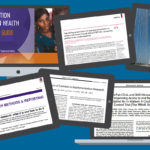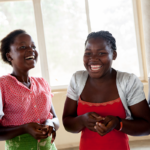Colleagues in global health and development, donors, extended networks, my ever-curious parents and even researchers themselves have asked me to define research utilization. I’ve heard it asked time and time again. The terminology can seem quite elusive, to be fair, but this important practice spans every facet of what we do in the development world, and it should! – if we truly want to achieve and sustain maximum, lasting impact. In this post, I’ll explain what research utilization is and why it’s important.
What is research utilization?
In the context of global health, research utilization is the process of moving evidence into practice to improve the health and development of the people and communities we serve. It should be noted, though, that research utilization can be employed in any context or process where evidence is needed or used; it is not confined to the health sector or limited to only research studies. This framework illustrates that, regardless of where and when research utilization is happening, it is ongoing and must occur before, during and after evidence is produced in order to achieve successful results.
To attempt to put it simply, research utilization is an action. It is also the connective tissue between evidence and action. It can be comprised of planning, networking and communication, production, dissemination, advocacy, capacity building, policy development, and program adaptation. Early listening to discern the priorities of stakeholders, beneficiaries and countries – as well as convening evidence end-users with study teams – is research utilization. Digital or virtual engagement and social media can be research utilization. Knowledge management and dissemination can be research utilization. Evidence-based trainings of clinicians and the development of job aids and toolkits are also examples of this.
Research utilization is not just a cog in the wheel of development. It is the wheel. When done right, it includes some form of ongoing stakeholder engagement, networking and needs assessment across global, regional and national learning exchanges. Easy enough, right? Not quite. Strategies are also developed to scale up effective practices and programs and ensure that the evidence is used in decision-making and the development and promotion of policy. And, while all of this is taking place, we employ technical assistance to synthesize new and existing evidence; develop service delivery guidelines, job aids, curricula and other materials; and disseminate the evidence.
Why is research utilization important?
The value of incorporating research utilization into every aspect of development can be infinite, but measuring that value can be quite hard. What good is evidence if it is not used? What good is strong research if no one reads the journal article or learns from it? If a tree falls in a forest and no one is around to hear it, does it make a sound? These are big questions. The point I am trying to make here is that, while it is incredibly controversial to say that research has the potential to be useless, it absolutely is useless if it fails to be seen, heard and used.
Think of the incredible effort that goes into producing a research paper or journal article. It is quite an accomplishment to have research published in a reputable source, but I think we aren’t doing our due diligence if we simply stop once we’ve reached that marker of success.
I argue that we have a framing problem – globally – when it comes to measuring the success of research. Instead of thinking about “getting published” as the ultimate sign of success, we need to think about “getting published” as just the beginning. Even I, back in my intern days, fell victim to this line of thinking. It was one of my written goals to “get published.” But why? The real marker of success that we should be striving for lies here: Is our research being used to improve programs and outcomes? If so, how? What is the impact? Is it being scaled up in other programs or locations? Was it added to the agenda of decision makers? Did it lead to policy change? This is the value of research utilization. It ensures that the tremendous amount of time, money and resources poured into conducting research is used efficiently and the return on investment for programs is strong.
What is the future of research utilization?
Signs point toward an increased recognition and demand for the research utilization process itself. Over the past two decades, various world leaders have marked the importance of translating knowledge into action, and some have even developed their own frameworks, guidelines or toolkits for how to “do” research utilization within global health and development. These efforts are a welcome change of pace, especially considering a 2011 study that concluded it can take an average of 17 years for research findings to be translated into practice.
How do we improve research uptake in low- and middle-income countries? How can we continue to meaningfully contribute to this field? I argue with greater intention and attention to detail. I help my colleagues incorporate research utilization into proposals, protocols, projects and programs more now than ever before. Why? Because there can be no lasting success – no positive, systemic answers to our world’s most complex challenges – without it. The future of research utilization is bright, but there is much work to be done. The development community must lead by example and continue to advocate – demand, even – that the practice be employed at every stage of research until it is normal – expected – to do so.
Photo credit: Jessica Scranton/FHI 360



